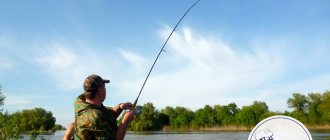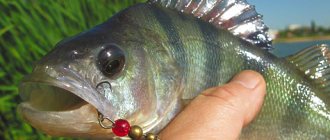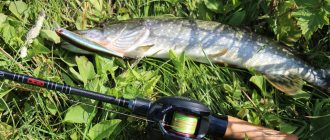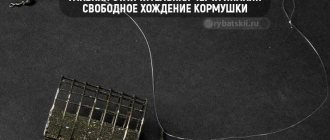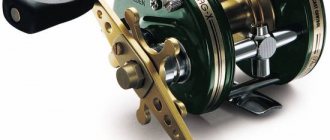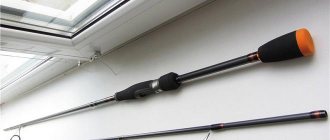Feeder, casting, fishing rod: how do spinning rods differ?
The difference in spinning rods can be quite significant and depends on the fishing method and the fish being hunted.
Even in different regions of Russia, a variety of fishing rods are used. For example, in the northern regions they use powerful whips, which is due to the catching of large and active fish - salmon, taimen. In the coastal zone, among aquatic vegetation, completely different fishing rods are used. Carp fishing requires other characteristics for the form. That is, it is impossible to get by with some kind of universal fishing rod, because otherwise fishing will simply be unsuccessful. The difference between one type of spinning rod and another is fully justified by centuries of experience and practice.
Comparison
There are quite a lot of nuances that allow us to differentiate the devices under discussion and the fishing methods associated with them. Let's start with the principle by which fishing occurs in each case. Thus, feeder fishing is based on the constant portion supply of bait into the same area of the reservoir, creating a so-called bait spot.
When fishing with a donk, a feeder can also be used, which increases the chances of a good bite. However, the bait in this case is made thicker. The fish sucks out the food, and at the same time there is a chance that it will get hooked. Nevertheless, the difference between a feeder and a donkey is that when fishing with the latter method, it is more difficult to achieve the accumulation and retention of a large number of individuals in one place.
The feeder provides easy and accurate casting due to its flexibility. In general, a rod of this type is designed in a special way. It is equipped with a reel and has many through rings. But its main characteristic is its thin, sensitive tip, which signals any, even very careful, bite.
In a donk, a bell is usually used for this purpose, fixed on the rod itself or on the fishing line. In a certain sense, this should be recognized as an advantage of the bait, because you can be distracted from it if necessary (for example, to switch to another tackle) - the bell will indicate that a fish has been caught. But due to the fact that the bell also sounds from the wind, there is a risk of missing some bites. The feeder wins in case of wind.
It should be noted that the feeder is distinguished by delicate equipment with thinner leader material, which is why the fish are less afraid. Of course, there are exceptions, for example hunting for large carp, but this is a separate case. And so, despite the “cobwebs”, you can catch very large specimens with a feeder. An important feature of modern equipment is the use of a single hook.
If we talk about such an important point as hooking, then when fishing with a feeder, the responsibility for it lies with the fisherman. However, for many avid anglers, this is precisely what makes them most enjoyable. The feeder allows you to feel the entire bite from the beginning until the moment of hooking. The resistance and jerks of the fish will be transmitted directly to the hand.
We invite you to familiarize yourself with: Ice drill for winter fishing - TOP 4 best models [2019]
There are at least two more important points by which the considered methods of organizing fishing can be compared. What is the difference between a feeder and a donkey? The fact is that the feeder has much greater capabilities in terms of long-distance casting. This is extremely important when, say, you need to reach a riverbed hole without a boat.
And one more significant nuance - if the reservoir is unfamiliar, then you can get used to the feeder in the best possible way. A sensitive rod will allow you to “probe” the point to find a promising place. All bottom irregularities will be transmitted through the feeder, and the flexible tip of the equipment will indicate the moments when the load touches the underwater surface.
It can be quite significant and depends on the fishing method and the fish being hunted. Even in different regions of Russia, a variety of fishing rods are used. For example, in the northern regions they use powerful whips, which is due to the catching of large and active fish - salmon, taimen.
In the coastal zone, among aquatic vegetation, completely different fishing rods are used. Carp fishing requires other characteristics for the form. That is, it is impossible to get by with some kind of universal spinning rod, because otherwise fishing will simply be unsuccessful. The difference between one type of spinning rod and another is fully justified by centuries of experience and practice.
The problem of choice: what is the difference between a spinning rod and a fishing rod
Having asked the question: is the difference between a spinning rod and a fishing rod significant or not, let’s try to remember what kind of fish they are intended for catching. Spinning is used to catch predatory fish using artificial bait. The length of the whip is from 1.8 to 3.3 m. Test and action depend on the fishing method. For example, for trolling (dragging bait behind a boat), the length of the rods is short, but they have a high test to cope with strong fish.
For fishing for peaceful fish, the difference between a spinning rod and a fishing rod becomes clear. The concept of “fishing rod” hides a variety of fishing designs, used, again, depending on the conditions. Even an ordinary float is divided into several categories.
Fly fishing rods are designed for fishing close to the shore. Often they do not have passage rings and, accordingly, a coil. The fishing line is attached to a special ring located at the end of the rod. The length of such fishing rods ranges from 3 to 8 m.
For long-distance casting, match rods with a plug connection method are used - joining the knees. They are equipped with a large number of guide rings located on high stands to prevent the fishing line from sticking to the rod. They are made up to 5 meters long for efficient long-distance casting.
So, the design differences of a regular fishing rod:
- Rods are made of bamboo, fiberglass, carbon fiber, and may not have guide rings. A special loop is used to secure the scaffolding.
- The equipment can be blind or sliding; a float is used as a bite alarm.
- A sinker and a hook are used to catch fish.
Now it becomes clear how a fishing rod differs from a spinning rod. The latter has similar equipment elements, but the rod is equipped with a reel seat and guides. Fishing with a fishing rod is more passive, since most of the time the tackle is located on stands, and the angler’s task is to motionlessly watch the bite alarm.
Choice of rod: front or rear drag?
The front clutch allows you to adjust the reel more accurately, it is more reliable, and it costs less. However, for beginners, a reel with a rear drag will be more convenient.
Fishermen often prefer reels with a baitrunner; for many, this model is the most convenient. The double friction adjustment system allows you to adjust the tackle so that even a novice angler can easily cope with a trophy of 10 kg or more.
Victoria Leshchenko
I've been working hard in the fishing tackle department for the past six years. I can help you assemble almost any gear.
Ask a Question
However, this is a personal matter for each angler; the rear one allows you to change the force in the process of fishing or pulling out the feeder, for example, when you have cut a lot of grass and you need to tighten the clutch.
Rocker or endless screw?
The eternal debate between anglers about the mechanism that lays the line better should still be resolved here in favor of an endless screw. Firstly, the rocker will experience uneven loads at the beginning and end of the stroke, which will sooner or later lead to faster wear. Secondly, the endless screw provides a more even lay, and the drawstring, even a very good one, will make a very small dip in the center of the winding. That is why they try to adjust the reels with slides so that they wind the line with a slightly reverse cone. But if you use a large amount of fishing line and backing, all these failures will be compensated by its elasticity.
Another point to note when choosing an endless screw reel is the price. A good endless screw costs good money. It must be made of high quality bronze or brass, precisely crafted. Such a reel immediately goes for a price tag of $100. You can buy a reel with a screw cheaper, but it will still be less reliable than with a rocker mechanism. Therefore, if your wallet does not allow it, buy what you can afford, and do not chase after show-offs like a screw in a reel - better a small bird than a big cockroach.
The line laying mechanism itself can work in different ways. This depends on the frequency of changing the feed direction. Some coils work in such a way that the direction changes almost every turn of the handle. Others change it less frequently. Frequent changes in direction are more typical for rocker mechanisms and are called “sinus laying”. It is suitable for spinning fishing, when the bait is twitched and the tension during reeling is uneven. By the way, in spinning, the twitching technique is fully feasible only with multipliers. In the feeder, the so-called “sinus” laying is unnecessary, since the tension during winding is almost the same. You can choose a cheaper reel with a more reliable, but simple installation.
Weight is usually an argument that is expressed when justifying the price. As a rule, more expensive reels have less weight with the same characteristics. Is this characteristic so important for feeder fishing? The fact is that in the hands of the fisherman there is a fairly heavy fishing rod, more than three meters long. He holds it with both hands. A 100-gram feeder dangles from the tip when casting. Definitely, even if the reel is quite light, it will not give you the feeling of a feather in your hands, as when fishing with an ultralight spinning rod. Even when fishing with pickerel. Therefore, you can purchase relatively inexpensive Saubers and Arctics, which have significant weight, and fish with them as comfortably as with the top-priced line from Shimano. Well, of course, Shimano is still better, but the choice may not be worth the money invested.
The handle is an element that receives little attention when choosing, but in vain! The handle experiences a lot of stress during operation. Therefore, it is worth choosing one that will be as durable as possible. It should also be as simple as possible. For example, when choosing between a pen with a button and a monolithic pen, it is easier to choose a regular one. It's more reliable. The handle material usually matches the body material.
The handle is an individual matter for everyone
This is the place where your fingers hold when working with the coil, through which contact occurs most often. Some prefer a knob, others prefer a pin. Fortunately, most reels allow you to change the handle if desired. You can purchase spare parts in online stores. The author prefers a knob; it’s easier to twist with more force, and it’s easier to catch it without looking. The arguments in favor of small pins are not clear and are due to some callous views on coils.
The housing material for the feeder coil can be special plastic or metal. Expensive reels are made of titanium. Most anglers should opt for metal reels as they are both stronger and more durable. In plastic ones, the seats for the gears of the gearboxes wear out quite quickly, the shape is distorted, and they begin to work worse. But if it is expensive plastic, this may not happen. In any case, a cheap metal reel is better than a cheap plastic one.

Spool and rotor
For good fishing, the spool must be made of metal. This will allow you to fish with both cord and fishing line. It also needs to have a hard coating on the edge of the spool to avoid wear from the cord. When purchasing a reel, you should inquire in advance about the availability of an additional spool, and if possible, buy two identical ones. Why the same ones - it’s easier to reel in fishing line and backing. And in some cases it is worth purchasing not two, but three or more. A feeder reel is a fairly universal thing and is suitable for several fishing rods. One can cover several types of feeder fishing at once, but more on that later.
Line guide and clip
These two small details affect fishing just as much as the handle. The clip should be comfortable. It should be large in size so that you can thread a fishing line through it without any problems. It is best to use a spool with a metal round clip. Unfortunately, most reel manufacturers, even those specialized for feeders, miss this point. It is beneficial for them to make a small, weightless clip so that it does not affect the balancing of the spool, which is very difficult to wind the line, especially with fingers stiff in the cold. If there is a reel on sale with a suitable clip, take it without hesitation; usually it is the one that is most suitable for the feeder.
The line layer must have a good hard coating in order to work with both fishing line and thin cords. It operates under constant high tension, so it needs a bearing. When reeling in, the angler often forgets to close the bracket, so you need to pay attention so that it closes effortlessly and does not jam. Whether the bracket is hollow or made from a single piece of wire makes no difference, because the mass of the reel is not the most important characteristic in feeder fishing.
Is the difference between a spinning rod and a feeder really that significant?
Both of these rods are characterized by the following indicators: test, action, length. We talked about these indicators in the article “How to properly organize spinning fishing for predatory fish.” If we briefly decipher these indicators, the form test indicates the maximum loading weight of the gear, the action indicates the ability to bend under the influence of load, the length of the rod directly affects the delivery distance of the bait.
The first thing that distinguishes a spinning rod from a feeder rod is its length – it is somewhat shorter. Spinning fishing is more active, so casting bait should be more comfortable both from the shore and from the boat. During one fishing trip, the form has to be rethrown hundreds of times; therefore, special attention is paid to the lightness of the gear.
Another factor that distinguishes a feeder from a spinning rod is that the feeder rod is equipped with replaceable tips, the so-called quivertips. They do not participate in casting the tackle and serve as a bite alarm. Spinning tackle does not use a similar design; the bite is felt by the angler’s brush.
The tips are divided according to the degree of sensitivity:
- For fishing in still water or in light currents, soft tips are used;
- medium ones are used for faster water movement or strong wind;
- a significant current forces you to set up the tackle with rigid quivertips.
Both types of fishing rods are currently made from the same components: fiberglass, carbon fiber, composite materials. The most expensive blanks are made of carbon with a cork handle.
The difference between a feeder rod and a carp rod is an obvious but not strict fact
Both of these rods are characterized by the following indicators: test, action, length. We talked about these indicators in the article “How to properly organize spinning fishing for predatory fish.” If we briefly decipher these indicators, the form test indicates the maximum loading weight of the gear, the action indicates the ability to bend under the influence of load, the length of the rod directly affects the delivery distance of the bait.
The first thing that distinguishes a spinning rod from a feeder rod is its length – it is somewhat shorter. Spinning fishing is more active, so casting bait should be more comfortable both from the shore and from the boat. During one fishing trip, the form has to be rethrown hundreds of times; therefore, special attention is paid to the lightness of the gear.
Another factor that distinguishes a feeder from a spinning rod is that the feeder rod is equipped with replaceable tips, the so-called quivertips. They do not participate in casting the tackle and serve as a bite alarm. Spinning tackle does not use a similar design; the bite is felt by the angler’s brush.
The tips are divided according to the degree of sensitivity:
- For fishing in still water or in light currents, soft tips are used;
- medium ones are used for faster water movement or strong wind;
- a significant current forces you to set up the tackle with rigid quivertips.
Both types of fishing rods are currently made from the same components: fiberglass, carbon fiber, composite materials. The most expensive blanks are made of carbon with a cork handle.
A type and optimized bottom tackle is considered to be a feeder rod. The main features of the feeder are the presence of a sensitive tip, which instantly reacts to a bite. There is a feeder classification:
- Easy class.
- Middle class. The most popular one is used by professional fishermen and is suitable for beginners.
- Hard class.
- Ultralight class (picker).
- Super heavy class (for fishing in difficult conditions).
Like a spinning rod, a feeder rod is characterized by test indicators. You should not deviate from the test parameters when choosing a form. It is better not to reach the maximum indicator with a margin of 10 g. The feeder rod visually consists of three or four components, and can reach up to 4 meters in length.
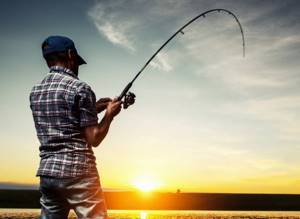
As with marking a spinning rod, feeders have an action parameter. The longer the rod, the higher the action, and light and short, the slow and medium. But manufacturers prefer to produce fast tuning, medium tuning very rarely, and slow tuning which is rarely seen at all.
Feeder and spinning rods are designed for catching fish; they have the same purpose. But, there are significant differences in the methodology and area of their use. Feeder rods and spinning rods are designed for completely different types of fishing. Feeder, after casting you can put it on the stand and wait for a bite. The spinning rod must be held in your hands at all times.
A feeder rod is much heavier and longer than a spinning rod. In addition, fishing with a spinning rod is much more active than when using a feeder. You can change the tips on the feeder, which indicate flexibility and the degree of bite; the spinning rod has no removable parts. What type of gear to choose is a purely individual question, which depends on preferences, type of fish, type of water body and financial capabilities.
Global hobby of real men
We suggest you read: Fishing in the Autumn on the Feeder
Against the backdrop of the ever-increasing popularity of fishing, the right choice of fishing rod is of great importance. Experienced fishermen have long known the criteria by which they can choose the fishing tool that is best suited for them personally. But what should those who are not so experienced in fishing and have never before chosen a fishing rod and tackle do? This article will publish the main criteria for choosing fishing rods, which will help you make the right decision and spend your money wisely.
Unlike carp rods, feeders are slightly more aesthetically pleasing. They are considered to be more suitable for beginners in fishing, especially when it comes to telescopic feeders. They have a fairly thin blank, shorter elbows, greater length, and pass rings are placed on high footrests.
Feeder rods are not designed for particularly intense muscle work and are generally somewhat more fragile than carp fishing rods, but they are also well suited for catching active bottom fish - crucian carp, bream, rudd and even carp. Almost always, the feeder rod comes with an attached signaling head, often painted with bright fluorescent paint.
There may be several of them, designed for different weights of the feeder. Typically, such rods are made in a three-piece form (carp rods are most often two-piece). They are more designed for catching a wide range of white fish, primarily bream. In addition, there are various forms of devices and improvements that orient the feeder for catching such difficult fish as barbel and carp - stronger and more rigid signaling tips, wide and voluminous feeders, fast action.
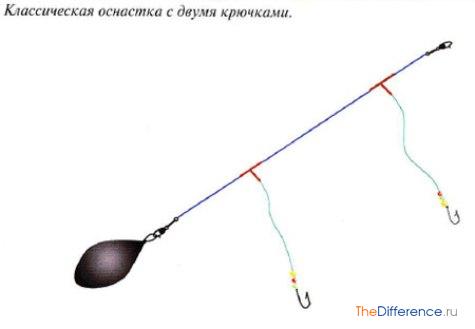
This is the difference between a feeder rod and a carp rod. One of the representatives of the top feeders is the three-part Preston Absolute 12′ SuperFeeder with a length of 360 centimeters. Along with a pleasant design, the manufacturer has given it excellent characteristics that are superior even to some budget models of heavy carp rods.
A carp rod is designed to use much heavier equipment, voluminous feeders and is intended for catching larger and more aggressive fish. The structure of a carp rod is completely different from the elegance inherent in feeder rods. This is a strictly functional machine, designed primarily to perform its task - catching trophy fish.
The powerful structure requires maintenance with the help of a large application of physical strength: a strong, long and thick handle, joints located at a great distance from each other, reinforced access rings. As a rule, the length of such a rod rarely exceeds four meters, despite the fact that they are aimed at long-distance casting.
This is the difference between a carp rod and a feeder rod. One of the typical representatives of this type of rod is the Salmo Taifun TeleCarp. It is made from high-modulus fiberglass, has a length of up to three meters and is capable of throwing bait weighing up to one hundred and ten grams. It is able to resist the largest river and lake fish, and is perfect for catching silver carp, carp and grass carp.
Advantages of feeder rods over carp rods
What is the difference between a feeder and a carp rod?
– do not require much physical strength;
– more versatile and ergonomic: feeders are often used in combination with floats, pop-up boilies or other types of rods (even a feeder made from a carp rod is also a fairly common modification), which significantly increases the list of fish species caught;
– a wide selection of signaling tips;
– long rod length, which makes long casting easy;
– more convenient to transport due to lower weight and transport length;
– top feeders are practically in no way inferior to carp feeders in terms of parameters and functionality;
– have a more pleasant appearance.
I am starting a large series of articles about feeder fishing. If you look at it, the Feeder is the same traditional donka with a feeder, only very modernized. The Feeder uses special rods, reels, lines, feeders and other elements of gear. In general, everything is special and ultra-modern. And the efficiency of fishing with a feeder is, accordingly, higher than with the antediluvian donk. Why? And what are the secrets of the feeder? So we will analyze these subtleties in the articles of this section. Let's start!
Now I’ll give you a quick overview of the principles of the structure and operation of the feeder. And in subsequent articles we will chew all the secrets and subtleties, as they say, grain by grain.
So, I have already said that the feeder is the donk of the 21st century. A very modern method of catching peaceful fish from the bottom. The basis of any feeder tackle is the rod (actually, the Feeder). On this blog I focused on spinning fishing (my favorite), and more than once I talked about spinning rods. With the characteristics of the feeder, everything is approximately the same.
Typically, the length of a feeder rod ranges between 2.5 and 5 m. It is logical that the longer the rod in your hands, the further you will cast your equipment, and without any extra effort. The question is whether this is always necessary. Reservoirs are different. On small bodies of water and where the edge is close to the shore, shorter rods are quite suitable.
The feeder allows you to make very long casts and is extremely demanding on the sensitivity of the tip of the tackle. So in 99% of cases the feeder is purely shore gear. Due to the decent casting range, there is no reason to resort to a boat. And the slightest disturbance on the water, even if the boat is on the prods, will disrupt the sensitivity of the feeder.
We've sorted out the length. As for the structure of the feeder, everything is exactly the same as with a spinning rod. A feeder rod with a slow action bends almost from the handle when loaded. Fast - only at the top. Medium – something in between, 1/3-½ of the length of the form.
We invite you to familiarize yourself with: The best winter lures for pike Top 5 rating of catchable lures. Fishing for pike in winter using lures
Naturally, there is no universal feeder rod. So for different fishing conditions you need to have the appropriate gear.
The feeder rod test determines what weight of equipment it can cast. When making calculations, we should not forget that in feeder fishing feeders are used and the nominal weight of the sinkers and feeders should be added by 20-30g per bait weight.
The main difference between spinning and casting
There are several signs to understand the difference between a casting rod and a spinning rod. For example, the diameter of the passage rings is small; they are mounted on a low stand. But the number of rings has been slightly increased and they have been moved to the other side of the rod in relation to the reel. The casting form is equipped with a multiplier reel.
Multipliers are used on somewhat powerful whips, which is why by increasing the number of guide rings the rod is unloaded more evenly. The multiplier is an improved type of conventional inertia-free gear; its operation is based on the principle of a winch. The use of a multiplier reel is due to the large mass of bait when casting.
Now let’s try to consider not how a casting spinning rod differs from a regular one, but what their similarities are. Perhaps there is only one thing: spinning rods are determined by test and structure. The casting pattern is also determined by the fishing conditions. If you will be jerking with persistent baits, you will need a short and rather rigid blank.
Choosing a spinning rod for a feeder
Along with classic spinning fishing, feeder spinning fishing is gaining popularity.
Translated from English, “feeder” means “feeder.” This idea originated in England. Simply put, food is served to the fish in a special feeder. And there the hooks with attachments are already waiting. A modern version of fishing with a feeder is called quivertip. Only special blanks are used, match ones with a very sensitive tip. The latter plays the role of a bite alarm.
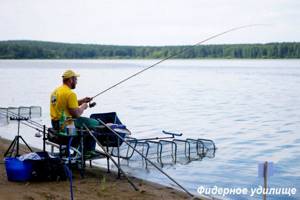
There are differences between spinning and feeder forms. Although these differences do not prevent you from fishing with a spinning rod as a feeder, or with a feeder as a spinning rod.
In a spinning rod, the strength and elasticity of the rod should exceed that of float rods. A simple spinning cast is sometimes on the verge of the strength of the tackle material.
Modern rods for spinning tackle are made of carbon fiber and carbon fiber with the addition of boron fibers, which create additional flexibility. The most common products now are made from multilayer composite with the addition of graphite. They have the inscription "CARBON" on them.
What is the difference between a feeder and a spinning rod:
- The feeder rod is quite long, up to 4.5 meters and heavier than the spinning rod. It is used for bottom fishing; after casting, it is fixed in the stand. The spinning rod is held in the hands and the reel is constantly rotated. The length of the feeder is an important indicator; it determines the casting of the feeder over a long distance.
- Feeder forms have the same indicators as spinning forms: test, action, length. They show the weight of the bait, which can be cast without fear of breaking the tip. The structure of the whip is characterized by its convexity under load;
- Spinning rods are much shorter than feeder rods. This was done for ease of throwing. Spinning fishing is active; you have to cast baits of different weights hundreds of times. With a short whip, the angler will not get so tired.
- An important difference between a spinning rod and a feeder is the presence of a tip on the latter. The fisherman feels the bite, this is not the case with a spinning rod. There, holding the fishing rod constantly in his hands, the angler hears the fish hitting the bait.
Special mention must be made about the top. Its sensitivity is measured in ounces. The ounces indicate how hard you need to press the tip of the tip to bend it 90 degrees. The toughest are the 6-ounce ones.
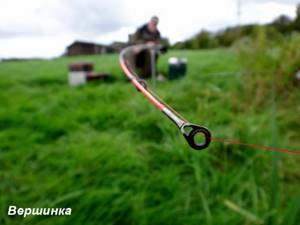
The tips are divided into three degrees of hardness.
- Soft - used in standing water;
- Medium - for fishing in small currents, or in windy weather;
- Hard - used on rivers with strong currents.
The tips do not take part in the throwing process; they transfer the weight of the load to the form. When choosing a tip, you should know the speed of the current and the weight of the feeder being thrown.
In addition to these differences, there are also great similarities between spinning and feeder rods. This concerns the material of manufacture: they are all made of fiberglass and carbon fiber. Composite materials (graphite and fiberglass) are also used. And the most modern materials for the manufacture of spinning and feeder rods are carbon.
For successful feeder fishing, an angler must know all the accessories for such fishing. Feeders can be factory-made or home-made. Its role is to deliver food to the place where the fish are located. It is both a bait for bottom inhabitants and a place for them to feed.
Voting: the best reels for feeder
Which feeder reel would you choose or recommend purchasing?
DAIWA Fuego 5000D-C XH LT (17)
28.26 % ( 13 )
Shimano 17 Ultegra C 3000 FB
10.87 % ( 5 )
Ryobi Excia MX 3000
15.22 % ( 7 )
Okuma Inspira ISX-30R
2.17 % ( 1 )
Salmo Elite Baitfeeder 7 4000BR
15.22 % ( 7 )
Stinger Forceage Neo 3000
4.35 % ( 2 )
Volzhanka Meteor 3000
8.70 % ( 4 )
Shimano Stradic CI4+ C3000 FB
2.17 % ( 1 )
Ryobi Arctica 4000
4.35 % ( 2 )
Which feeder to choose?
- Bait - for primary feeding of fish, attracting them to the fishing spot. Holds a large volume of feed, has large holes for its quickest rinsing;
- Feeder for long-distance casting - similar to a badminton shuttlecock, good for casting to the right place;
- Supplementary feeding - good in still water and in currents, has different cells for slowly washing out the feed. Its task is to keep the fish in one place for a long time.
Choice of bait
The success of feeder fishing depends on well-chosen bait. The bait is based on various cereals and cakes. They also add aromas and worms. Each fisherman has his own secrets for preparing bait.

The feeder is filled at the fishing site and always with fresh food. An exception may be fishing for carp, which is called “water pig” because of its omnivorous nature. Throw a feeder with hooks attached to it to a possible location of fish. Fixed on a stand at an angle to the plane of the water. This makes it more convenient to watch the moment of the bite.
Is there a significant difference between a spinning rod and a feeder?
Both the spinning rod and the feeder are designed equally for successfully catching fish, especially predatory ones. In order for it to be successful, you must have some knowledge and practical skills in this gear.
When purchasing a spinning rod, you do not need to deviate from these parameters. When planning a spinning fishing trip with a feeder, you need to choose a spinning rod with a safety margin. This gear is designed for fishing from the bottom.
Both spinning rods and feeder forms have their own structure. The longer the whip, the higher the action indicator. These rods are suitable for long casting on lakes.
Feeders are also distinguished by a large number of passage rings; they provide the load evenly along the entire length of the form.
The main difference between a feeder and a spinning rod is the replaceable tip. There are several different hardnesses included when purchasing. It can then be attached to a spinning rod. Otherwise, both of these gears are almost alike.
And it must also be said that fishing with a spinning rod for feeder fishing is passive fishing. And this is according to the taste and character of every fisherman.
Why use a spinning rod instead of a feeder?
The answer to this question is quite simple - the desire for universality. Naturally, no one is talking about completely replacing the feeder with a spinning rod; this is impossible due to their characteristics. In many respects (test, reel, etc.), the feeder begins where the spinning rod actually ends. And yet, there is the possibility of using one rod instead of another precisely at the “junction” of their characteristics.
One of the reasons for using gear for purposes other than its intended purpose is the lack of bite from the main fishing object. For example, in the spring, spinning anglers have frequent problems with predators biting. Therefore, so that fishing does not go in vain, many of them subject their gear to minor modifications, which allows the use of light feeder baits, although they are almost at the limit of the capabilities of a spinning rod.
Another, no less common reason is the attempt of some fishermen, as they say, to “sit on two chairs.” They either don’t want to spend money on a good feeder rod, or they simply want to get some kind of universal tackle that applies to both heavy spinning rods and ultra-light feeders.
Main differences
By fishing method
Spinning fishing is fundamentally different from feeder fishing. The latter is much calmer and unhurried, most of the time the tackle rests peacefully on the stand, waiting for a bite, and casts occur mainly when a new portion is delivered to the feeding area.
Spinning fishing is entirely based on constant casting and retrieving; there is no room for expectations or doubts. The entire fishing process, not just hooking and fishing, depends on the activity of the fisherman.
With a spinning rod, due to the design of the rod, the detection of a bite occurs due to the vibrations of the entire tackle that the fisherman holds in his hand, that is, the bite is felt by the fisherman not visually, but tactilely.
The sensitivity of a quivertype is expressed in ounces. It is equal to the number of ounces required to bend the quiver tip 90°. The lower this number, the more mobile the tip. The “tightest” tips have a sensitivity of 6.
Also, the tips differ in rigidity:
- soft ones are used in standing water;
- medium ones are used for minor currents or low winds;
- rigid ones are used in reservoirs with strong currents.
Therefore, depending on the conditions and the object of fishing, when using a feeder, you should have with you a set of tips with different sensitivity and rigidity.
By rod design
Spinning rods have shorter rods than feeder rods. The reason for this is the convenience for active fishing: spinning anglers have to cast the tackle up to hundreds of times, and its large dimensions and weight will lead to the fact that the fisherman will get tired faster.
Feeder fishing does not have a similar frequency of casts, since the time between casts is much longer. It is determined by the duration of dissolution of the bait in the input.
The length of spinning rods rarely exceeds 2.5–3 m; feeders can reach lengths of up to 5 m (although 2.7 to 4.2 m are predominantly used). This length is necessary not only for casting over long distances, it allows you to land fish through a hard edge. Using a long rod, you can “pull” the fish higher, passing it over the edge to avoid snagging.
The difference between a spinning rod and a feeder is also in the number of throughput rings. To ensure uniform load along the entire length of the rod, the number of feeders is greater.
Due to the greater weight of the bait, tests for feeders are greater than for spinning rods. Heavy class spinning has a test from 40 g and above (mostly up to 60 g, very rarely up to 100 g), while the test for a medium-light feeder starts from 60 g.
This is especially critical for spinning rods, since, given their small length (no more than 2.7 m) and relative lightness, casting bait over long distances will require a power cast. At the same time, the likelihood of breaking an overloaded tackle increases significantly. At the same time, the shortest feeder with a length of only 3 m allows you to easily throw heavy baits over long distances without any breakdowns.
Feeder reel for feeder fishing
First you need to understand that feeder fishing is different from spinning fishing. It uses a donka fishing rod with special bait. The feeder rod should have the most flexible top of the tackle, which will respond properly to bites. The rod is also equipped with a large number of rings, and all the upper parts of the gear are removable. This significantly increases sensitivity during bites. There is also a special feeder used specifically for feeder fishing, a fishing hook and a reel.
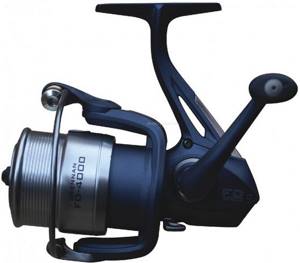
Feeder reel
From the above it should be clear that feeder fishing has its own specifics , which is reflected in the equipment. For the feeder, you can use any coils. It depends on the choice of the fisherman himself. However, the most practical and suitable for this type of fishing are spinning reels. Or rather, match inertialess reels. Their main difference from simple analog spinning reels is the presence of several spare spools that have a low level of depth and an improved transmission link mechanism. The fact is that feeder fishing involves the use of thin line. Namely, shallow spools simply do not allow the last one to fall between the skeins of unwound tackle. Thus, the convenience of the process itself is increased, where there is no need to be distracted by correcting possible problems.

Feeder reel for fishing
Also, the feeder coil is predominantly metal . This type of fishing is characterized by high dynamics, so the reel will be under constant loads of varying strength. A high-quality, reliable, well-built reel will last much longer than cheaper options that can break while fishing.
Expensive feeder reels are equipped with a baitrunner system , which allows you to almost instantly switch the friction brake from the minimum position to a full operating mode. Using the minimum position, the fisherman can calmly cast off the line, and returning to the operating mode allows you to quickly take control of new circumstances of the process - after all, large representatives are also suitable for small fish. This is how this system works, allowing you to completely control the fishing process. For feeder fishing, reels with a baitrunner system are recommended.
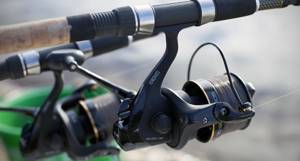
Modern feeder reel
Conclusions on the differences
As you can see, the difference between a spinning rod and a feeder is quite significant. And there is a very small area where these two types of rods can be interchanged with each other. Moreover, if a spinning rod can perform the function of a feeder, albeit to a very limited extent, then the reverse “reincarnation” is very unlikely.
Using a feeder as a spinning rod causes much more problems and inconveniences. For example, using a heavy and clumsy feeder as a quick-throwing tackle looks more than doubtful. Even if you remove the tip and try to select the rest of the feeder equipment so that it is as close as possible to the spinning rod, a slow action and a heavy long rod are unlikely to be able to correctly “transmit” bite signals to the fisherman’s hand.
When using a self-made feeder, you need to remember a number of simple things:
- It is necessary that the weight of the feeder with food and leash does not exceed the stated test by more than 10%.
- You should once and for all forget about power casting when working with such an “ersatz feeder”. It’s better to do without prey in the form of a dozen crucian carp once than to break your favorite tackle.
- All the time you are working with such a structure, you should remember that what is now in your hands is not a feeder. It has a different system, a different test and a different coil. All your actions should be accompanied by an adjustment to the “spinning” nature of the rod.
Thus, the answer to the question of whether it is possible to use a spinning rod instead of a feeder, of course, has a solution. However, this solution is not at all complete; moreover, such a transformation, to put it mildly, should not be abused, since the tackle can be irrevocably damaged.
How to make a feeder from a spinning rod
General principles
To use a spinning rod for a feeder, it needs to be slightly modified. Let's look at how to make a feeder out of a spinning rod with your own hands.
The main change that will be made to the design of the rod is the addition of a tip or quiver tip. It is also advisable to install a reel with a clip and a medium gear ratio. All that remains is a small matter: replace the fishing line on the spinning rod with a feeder line and attach equipment to it in the form of a feeder and a leash of a special design.
While there shouldn’t be any problems with the reel and equipment, installing the tip may take some time. In this case, there are two ways: with or without disassembling the last leg of the spinning rod. The first involves the use of ready-made quivertypes, which will be inserted into the modified last leg of the spinning rod. In the second case, you will most likely have to make the quivertip yourself, since attaching it to the top of the spinning rod without disassembling it is problematic.
What is better will be decided by the owner of the spinning rod independently, however, given that the resulting feeder will still be far from complete, it is preferable not to make irreversible changes to the design of the spinning rod.
What to look for in the store
First of all, these are backlashes. When buying an expensive reel, it is not uncommon for an expensive copy to have unforgivable gaps. Three types of backlash are checked:
- In the pen
- Rotor backlash
- Spool play
You can simply take the reel and twirl it in your hands, touch whether the handle is wobbly in its seat. Then shake the rotor where the line guide and bracket are located. The least critical are the backlashes in the spool, but they are also worth paying attention to. It is also worth paying attention to extraneous noises during operation - they simply should not exist at all, the new coil should work silently.
You should keep your receipt after purchase. Arriving home, they wind the fishing line onto the spool and watch how the reel winds it. If the quality of the winding is not satisfactory, and it winds unevenly, they simply take it to the store and change it or take the money. It’s definitely worth the time spent, you can even try to replace it with another coil of the same brand - it happens that it’s just a small defect in the batch.
It is also worth paying attention to other details - the length of the handle, the clutch and the quality of its operation, the slamming of the clamp and other points. If you have a fishing rod, it is advisable to come to the store with it to see how the reel holds on it. If the ceilings are high, even try waving. Of course, the final sensations will only be clear when fishing, when you cast a heavy feeder with a reel.

